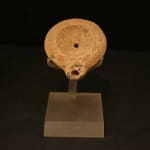Roman Terracotta Oil Lamp, 1st Century CE - 3rd Century CE
Terracotta
3.25 x 1
SP.361
This delightfully simple ancient lamp might have burned in a humble dwelling in one of the many cities of the Roman Empire. One can imagine the Apostle Paul writing his...
This delightfully simple ancient lamp might have burned in a humble dwelling in one of the many cities of the Roman Empire. One can imagine the Apostle Paul writing his epistles under the illumination of a lamp such as the present one, while traveling around the Roman Empire during his many journeys. The lamp of closed-bowl design was ubiquitous during the Hellenistic and Roman periods. The current one represents a design popular during the late Republic and the early Empire. Such a design was found not only on the Italic peninsula, but its influence was felt in other provinces of the Empire as well, such as that of Palestine. Made of terra cotta, this simple item would have held olive oil and probably a wick of plant fibers or textile, allowing it to provide light for a few hours perhaps. The small central hole was for refilling the cavity with fuel, while the larger hole at the tip was for placement of the wick. Often, the central panel on the lamp’s face would have borne some kind of artistic depiction taken from popular culture, but the concave face of the current example is bare, celebrating the simplicity of everyday artwork employed by the inhabitants of the Roman Empire during their daily chores.
A metaphor for joy and prosperity, for hope, for life itself, lamps have illuminated the path of civilization for centuries. They have shed light on mundane and extraordinary events alike, guiding great thoughts through the night, and standing vigil with lonely passions. In the presence of this simple object, we are in touch directly with a vanished world, with the rooms and shrines once warmed by its glow, with the people who drew comfort from its light. Today it remains as an enduring symbol of man's desire to conquer the darkness.
A metaphor for joy and prosperity, for hope, for life itself, lamps have illuminated the path of civilization for centuries. They have shed light on mundane and extraordinary events alike, guiding great thoughts through the night, and standing vigil with lonely passions. In the presence of this simple object, we are in touch directly with a vanished world, with the rooms and shrines once warmed by its glow, with the people who drew comfort from its light. Today it remains as an enduring symbol of man's desire to conquer the darkness.



